Great Reads in Photography: July 18, 2021
![]()
Every Sunday, we bring together a collection of easy-reading articles from analytical, to how-to, to photo features in no particular order that did not make our regular daily coverage. Enjoy!
Professor Makes Major Error in Banning Kit Lenses — Photofocus
A professor at a university in North Carolina has banned her editorial photography students from using kit lenses. These are the 18-55 mm (28-85mm equivalent approximately on full-frame cameras) lenses that come included with basic APS-C camera bodies.
The syllabus was recently shared on Reddit by a student in the class who wishes to remain anonymous. It sparked a lively discussion among photographers who largely disagree with the instructor’s point of view.
We connected with Kevin Ames, a Certified Professional Photographer by the Professional Photographers of America (PPA) and holding their designation of Photographic Craftsman. Ames is the author of four books, including one of the first renowned “Dummies” books printed in full color.
Five-Minute Sunday Interview:
Phil Mistry: Is it a smart decision for a photo educator to ban kit lenses?
Kevin Ames: This is an opinion, and as is often the case in these contentious times, it’s easy to say, “your opinion is wrong.” I strongly believe that Chase Jarvis is right when he says, “the best camera is the one that’s with you.”
The same goes for the lens you own. For a photo educator to ban a lens type based on its perceived quality is not the best course of action. Camera manufacturers make kit lenses so that their customers can buy a great affordable camera. It is not in their best interest to make a lens that performs badly. The corners cut are in the materials — plastic vs. metal. The kit lens simply won’t last as long. It’s a starter lens on a student’s starter camera.
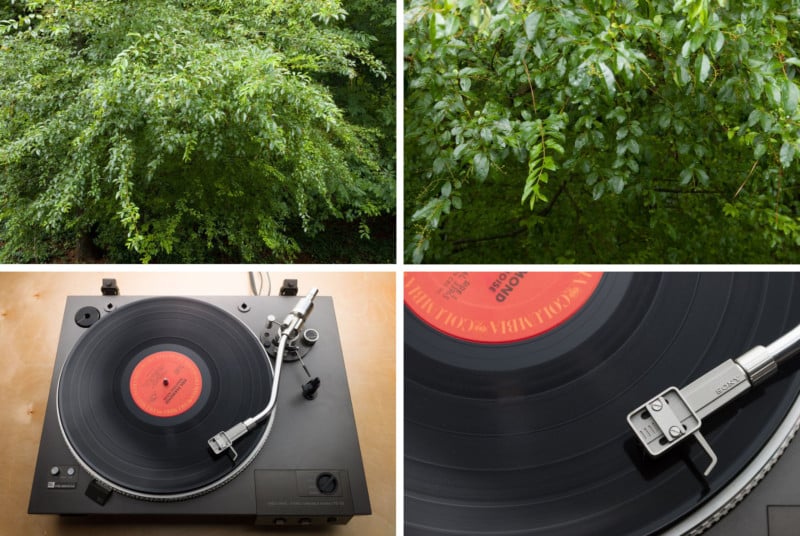
PM: In Bachelor of Fine Arts (BFA) and other fine arts programs, students often use pinhole cameras and other devices and techniques that do not necessarily produce sharp results. But if this class is on “Editorial Photography,” does that justify the ban?
KA: Heavens, no! Story is the point of editorial photography. Since story is the most important factor of this style of camera work, miscues that would be unacceptable in most commercial photography are welcome. A bit of blur due to subject movement, an off-kilter framing, and even the image not being totally sharp add authenticity to the editorial style.
PM: What is the biggest disadvantage of banning kit lenses?
KA: The unnoticed disadvantage to banning kit lenses is the reason they exist at all. The express purpose of these inexpensive — OK, cheap lenses is to get great cameras into the hands of people who want more from photography than they can get from their cell phones. Think of them as the first car any of us owned. It was most likely a beater. Not pretty, but it got us to where we wanted to go. The kit lens is just like that car. It gets us photographs with really good cameras. Don’t ban kit lenses! Embrace them. They want love too.
PM: Is it always obvious in an online image that it has been shot with a kit lens?
KA: It is not ever obvious that an online photo is made with a kit lens just by looking. Sure, you can check the metadata to see exactly which lens was used. Here are a few reasons why it will never be visually apparent. The most important factor is the resolution of the image. It will always be smaller than the original RAW file from the kit lens camera. Next, consider the screen upon which it is seen. Even zooming in on your phone’s screen, you’ll never see a kit lens’ flaw.
PM: What advice would you as a professional photographer give this professor?
KA: As a working photographer for my entire adult life, five decades or so, and a photography educator during that time for 3 of them, I’ve learned that being pedantic is not the way to teach. Patience is key, as is knowing how to present aspects of photography in different ways. I would offer the kit lens banning professor to encourage their students to check out lenses from the school and discover the difference in feel and how it works at apertures not available on the kit lens. One strategy is to require one assignment to be photographed with a lens other than the kit lens.
PM: Any other thoughts?
KA: Encouraging photographers to learn about the craft is the most important lesson a photo educator can provide. Today, after finishing a client’s portrait, we got to talking about his wife’s photography of children and family. She is ready and eager to learn everything she can. Were I working with her, the last thing I would do is to say her kit lens was not worth using. My job is to elevate photography by teaching my students how to be the best photographer they can be no matter what camera and lens they have with them.
Pulitzer-Winning Photojournalist Danish Siddiqui Killed Covering Taliban Clash in Afghanistan — CNN
“I shoot for the common man”: A slide show of Danish Siddiqui’s finest work.
Danish Siddiqui, a Reuters photographer who won a Pulitzer Prize for exposing the violence faced by Rohingya refugees, has been killed in clashes near Kandahar, Afghanistan.
Siddiqui was the news agency’s chief photographer in India, based in Mumbai. Reuters reported Siddiqui’s death on Friday, citing an Afghan commander who said he had been killed while covering fighting between Afghan security forces and Taliban fighters.
Magnum’s Great Escape: Confinement and Liberation – in Pictures – The Guardian
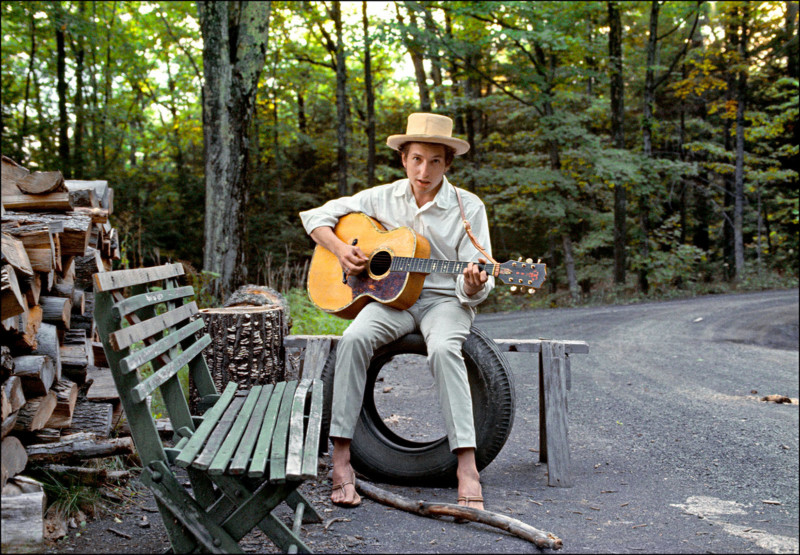
It’s been 16 months since the pandemic grounded the world. These images from Magnum’s July square print sale Way for Escape explore themes of being shut in – and getting away from it all.
Signed or estate-stamped museum-quality 6″ x6″ prints by Magnum Photos photographers are available here, for one week only, for $100 each.
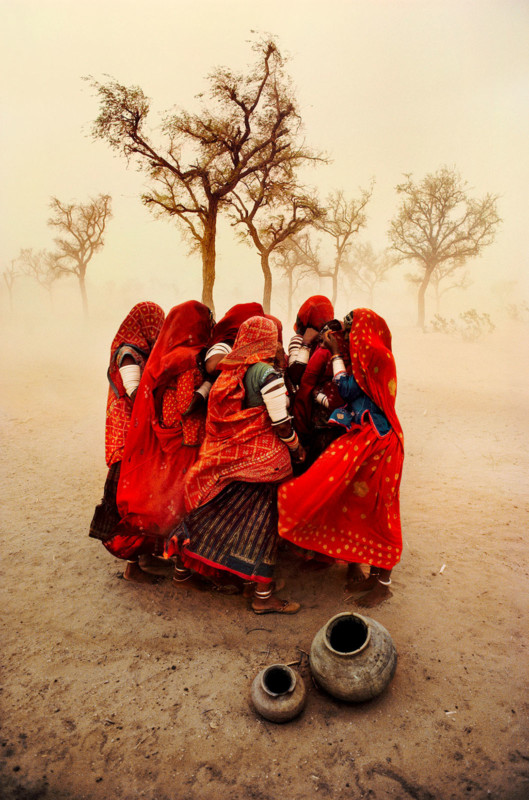
Some of these images represent how we construct our own sanctuaries. Steve McCurry (above) remembered capturing women in Rajasthan, India, experiencing a unique moment while singing a prayer for rain amid a dust storm. In contrast to this rural scene, Martin Parr’s (below) photograph from a bustling Hong Kong racecourse shows an individual immersed in observation, outfitted with binoculars and newspaper. Another image by Cristina De Middel and Bruno Morais shows a young tree swaddled in a translucent sheet. Their joint project examines how the natural world, and our conception of escape as a whole, is crafted for human consumption.
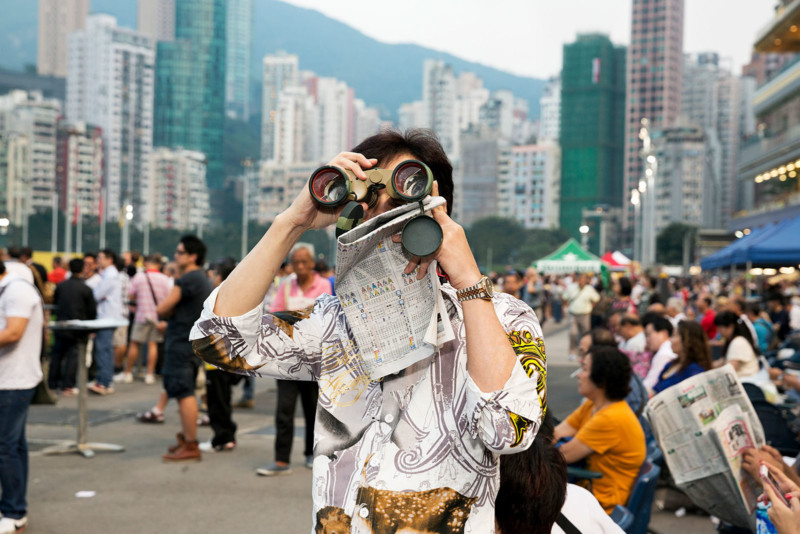
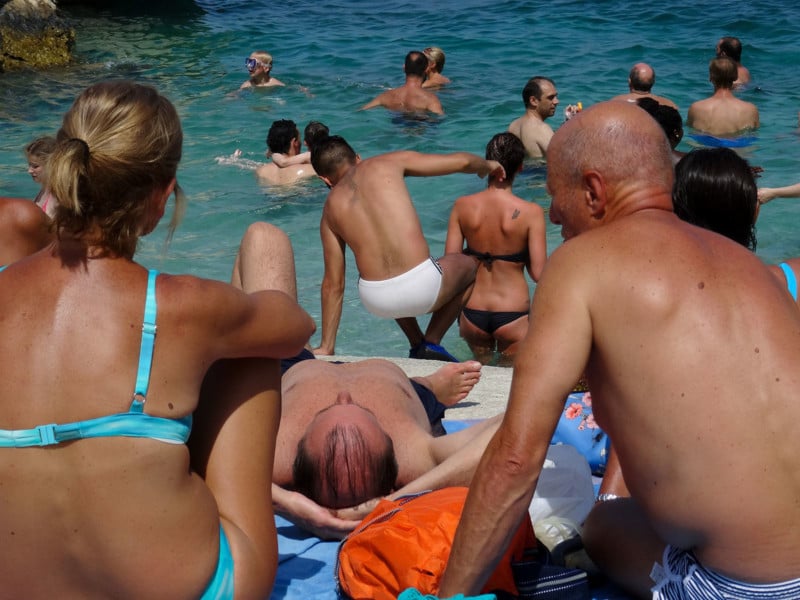
Photojournalists Under David Furst of The New York Times Felt ‘Set up to Fail’ – Columbia Journalism Review
The New York Times quietly parted ways with international picture editor David Furst in April after an investigation into his treatment of colleagues and freelancers, leaving many at the paper asking why his departure had taken so long.
Furst led the Times’ international photo department to increased prominence during his tenure, and he seemed to have star status inside the world’s most prestigious newspaper. But he was also known to undermine coworkers and abuse his position of power over freelancers.
Why Adobe’s New Presets Won’t End Built-In Photographic Bias – Lifewire
Adobe’s latest Lightroom presets are optimized for dark skin, but can they correct photography’s historic ethnic bias?
Just like “neutral” algorithms programmed by white computer programmers, photography has long favored white skin over black. In 2020, Twitter’s auto-cropping tool got caught ignoring non-white faces, but it goes back a lot farther than that.
“Supposedly, in the days of film, it was far different, and photographing dark and light skin tones was a big difference,” headshot photographer Rafael Larin told Lifewire via email. “But nowadays, the notion that there is a big difference is just no longer there.”
Read more:Here’s a Look at How Color Film was Originally Biased Toward White People
Naomi Rosenblum Broadened the Horizon for World Photography – Aperture
With Naomi Rosenblum’s death at the age of ninety-six this past February, an era came to a close. Historian, author, educator, and curator, she was a touchstone for many in the field of photography—so deeply embedded in the fabric of it, indeed, that some may be unaware of how she has shaped their world.
Peter Tsai Captures Spectacular Skyscrapers in ‘Cloud Chicago’ Photo Series – ABC 7 Chicago
Foggy days in Chicago with low clouds and rain are just dreary at ground level. But on these dreary days photographer, Peter Tsai is capturing his “Cloud Chicago” images.
Tsai camps out atop a couple of the Windy City’s most famous observation decks, including the Hancock Tower, and tucks his camera right next to the window.
“When that fog happens, it’s like a river flowing through the city, coming through. It’s rising, ebbing during those times I’ve spent,” Tsai tells ABC 7. “On one occasion, it was incredible, and I ended up spending four to five hours here. I didn’t even have dinner. I was starving, but I didn’t leave. It was like a once-in-a-lifetime thing. You see it, and you just want to get more and more of it. It’s so dynamic, especially if you capture it at sunset. The light is changing, and the clouds are changing. You wanna keep doing it.”
The Pictures That Saved Yellowstone – Discover
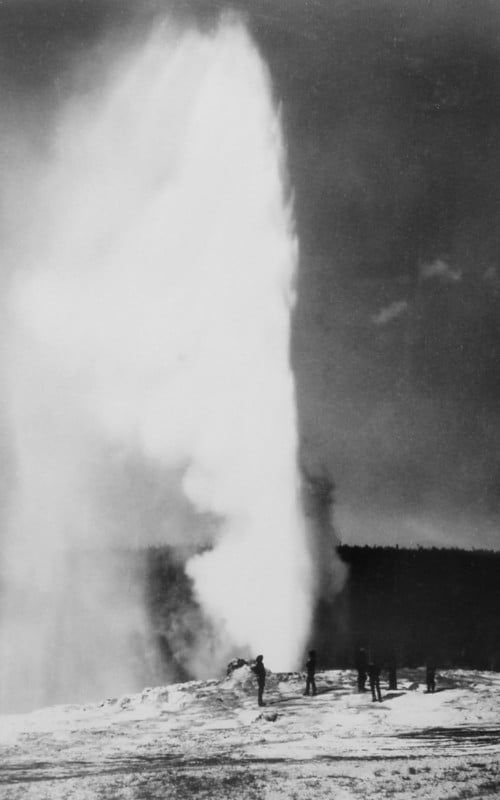
This year marks the 150th anniversary of a series of Yellowstone photographs by the renowned landscape photographer William Henry Jackson. He captured the first-ever shots of iconic landmarks such as the Tetons, Old Faithful, and the Colorado Rockies.
“People had been muttering tales of spouting water and sulfur springs going back to when John Colter split off from the Lewis and Clark expedition — but mountain men and explorers were known to tell some tall tales,” says Alicia Murphy, Yellowstone’s park historian to Discover magazine. “With Jackson’s photos, suddenly it showed people this was real and … really wondrous and unique.”
Large prints made by Jackson were distributed to members of Congress. The Senate and House, in quick succession, passed legislation protecting Yellowstone. Immediately afterward, in March 1872, President Ulysses S. Grant signed an act into law that established Yellowstone as the world’s first national park.
Why Your Headshots and PR Photos Suck, and How to Fix it –TechEU

1.) On the level
2.) Mind the background
3.) Stop the normal
For more tips and complete details, check the link above.
Why India, Mecca And Las Vegas Struck A Chord with This Iconic Iranian Photographer — NPR
Iranian photographer Jamshid Bayrami’s most famous photo was of an Iranian protester years ago, but he’s also used photography to explore the world. He spoke with NPR’s Peter Kenyon in Tehran about his career and some of his favorite scenes.
This Iceland Hotel Is Offering One Photographer a Month-Long Stay If They Can Capture the Northern Lights – Travel + Leisure
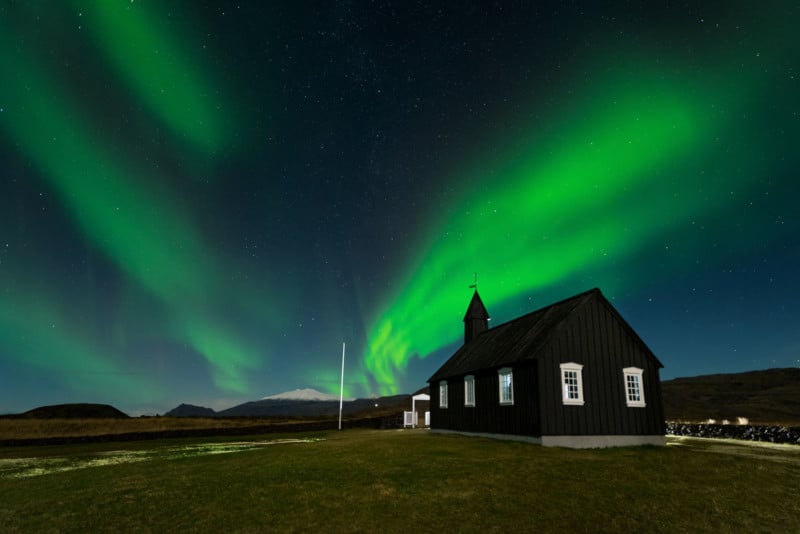
Hotel Rangá in Iceland is searching for its first-ever official “lights catcher,” a photographer who will spend a month capturing photos and video of the night sky’s colors in exchange for room and board.
The chosen photographer will also receive airfare to and from Iceland and must be available from mid-September to mid-October, with the ability to provide high-quality content, of which the hotel will retain the license.
How to Photograph a Bioluminescence Sea Sparkle – BBC
Photographers have been capturing “unforgettable” scenes of the sea lit with glowing plankton bioluminescence. Bioluminescence describes the light some living creatures, such as plankton and jellyfish, emit from their cells.
But finding and capturing the glow at the right time and right place requires patience, local knowledge, and luck, photographers say.
The Pros and Cons of Larger Smartphone Camera Sensors – Make Use Of

Nowadays, smartphone companies are jamming more megapixels into their phones’ cameras. Five years ago, a phone with a 20-megapixel camera seemed like a lot. Today, however, we see smartphones with over 100!
50 Photos from American Life in the 19th Century – 24/7 Wall St
Because of its proximity to the piers along the Hudson River, the area of Manhattan now known as TriBeCa (for “Triangle Below Canal Street”) was a thriving business district in the mid-19th century. No. 5 Hudson, seen at the right of this image, is now the site of Kings Pharmacy, a well-loved neighborhood business.
This Tiny Polaroid Camera Rekindled My Love for Instant Photography – New York

“It still has that winsome Polaroid look that we clamor for when using instant cameras,” says reviewer Jordan Bowman. “Using it taps into that nostalgia pleasure center of the brain.
“The pictures I took with it were more focused and brighter [compared to Fuji Instax], whether I was shooting people or things, indoors on a rainy day or outside with bright sun.
“There really is something transcendent about experiencing a special moment and then holding an image of it in your hands a few seconds later. And the Go has made that effortless.”
Quiz of the Week
1.) Which newly introduced 20MP image sensor camera can take photos even without a lens attached? Hint: It is made by a company that also makes lenses and flashes.
2.) Is it possible to squeeze out more dynamic range out of an existing camera sensor?
3.) Thirty years after its birth in the 1990s, JPEG still stands strong and essentially unchanged despite several unsuccessful attempts to replace it with JPEG 2000, JPEG XR, Google’s WebP, HEIC, etc. Is there a new attempt to dethroning the old JPEG?
Read also: How to Convert HEIC to JPG
4.) Sigma introduced a 200-500 mm zoom lens weighing 35 lb. and 29” long in 2008 with an MSRP of $25,999. What was the largest aperture on it?
a) 2.8
b) 4.5
c) 6.7
5.) Which celestial event will excite astrophotographers with the peak activity between 9 and 14 August? Hint: This phenomenon is primarily visible in the Northern Hemisphere.
6.) Which new cloud storage/backup service can handle RAW files and provide you a browser to view/organize your files with AI-powered tools? Hint: The company owns Flickr.
Answers
1.) Yongnuo YN455, a new android powered M43 mirrorless camera. Just like phone cameras, it has an 8 MP front facing camera. So, technically you can take a photo even without attaching a lens! (With apologies for a trick question.)
2.) Yes. Panasonic GH5 II does it with the same sensor as the GH5.
3.) Yes, by JPEG XL.
4.) It was f/2.8 at all focal lengths.
5.) The 2021 Perseid Meteor Shower
6.) SmugMug Source
Why I Like This Photo – Gulnara Samoilova
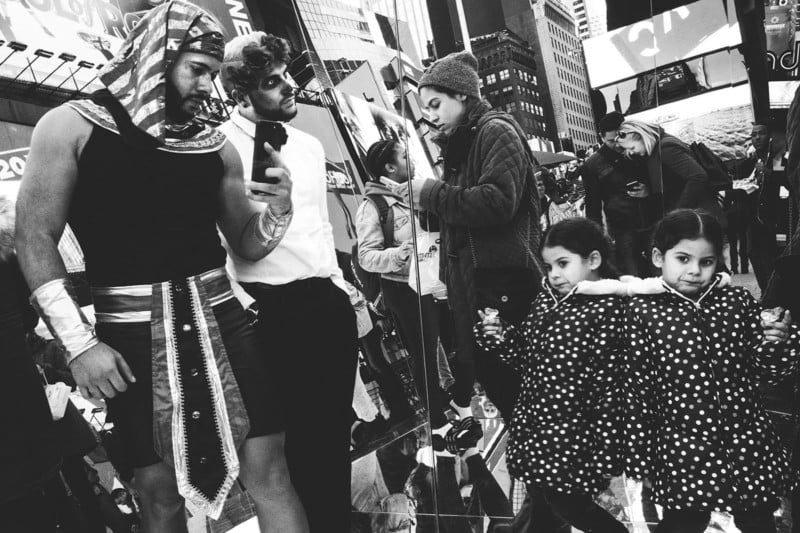
I like this photo because of the weird scenes around the frame. I love anything weird. I took this photo during Halloween weekend hence the costumes. I like the way the guy with white contact lenses looks at his own reflection. The girl eating ice cream and her twin reflection complete the frame.
I almost never use flash, so the photo is taken with natural light. I like to create layered photos, which is never easy. This particular photo is a little bit messy, in my opinion, but I love the moment.
I took this photo with Fujifilm XT2 and a fixed pancake Fujifilm XF 18mm F/2, my favorite lens.
I was on one of my street walks in Times Square back in 2016 when I came by a mirror installation titled “The Beginning of the End.” The sculpture was comprised of three giant mirrors and was created by Cuban artist Rachel Valdés Camejo. The photo is actually a reflection of people standing next to me, and the girl in front of me is leaning against one of the mirror walls.
Gulnara Samoilova is a fine art and street photographer based in New York City and the founder of @WomenStreetPhotographers Instagram feed, the traveling exhibition, and edited the book Women Street Photographers. Before moving to New York City in 1992, Gulnara was the only female fine art photographer in the Autonomous Republic of Bashkortostan, where she was born, in Ufa, the capital.
Quote of the Week – Raghu Rai
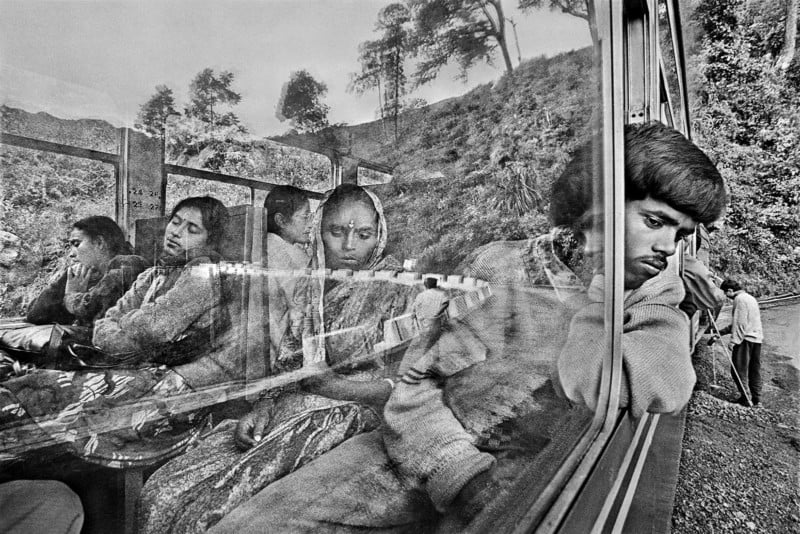
A photograph has picked up a fact of life, and that fact will live forever. — Raghu Rai
Impressed by an exhibit of his work in Paris in 1971, Henri Cartier-Bresson nominated Raghu Rai (b.1942) to join Magnum Photos in 1977.
To see an archive of past issues of Great Reads in Photography, click here.
We welcome comments as well as suggestions. As we cannot possibly cover each and every source, if you see something interesting in your reading or local newspaper anywhere in the world, kindly forward the link to us here. ALL messages will be personally acknowledged.
About the author: Phil Mistry is a photographer and teacher based in Atlanta, GA. He started one of the first digital camera classes in New York City at The International Center of Photography in the 90s. He was the director and teacher for Sony/Popular Photography magazine’s Digital Days Workshops. You can reach him via email here.
Image credits: All photographs as credited and used with permission from the photographers or agencies.